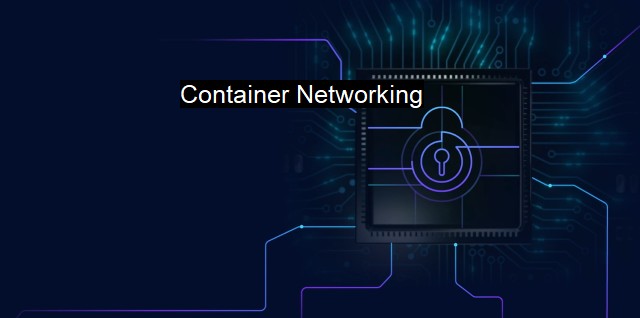What is Container Networking?
Secure Container Networking: Enhancing Scalability and Compatibility for Cloud-Based Applications with Container Technology
Container Networking is a holistic term that encores a variety of operational tools, strategies, and technologies that are utilized to connect, integrate, and secure different containers within modern cloud architecture and the broader field of information systems. The main aim of container networking is to facilitate and secure the communication between different container clusters, either operating on the same host or across different hosts, within a wide area or local area network.Containers are an essential part of microservices architecture and have been increasingly employed in infrastructure automation initiatives. They are lightweight and can encapsulate the necessary dependencies, ensuring the services run smoothly irrespective of the environment they are installed on. for these containers to function optimally, there is a constant need for communication between them. And that's where Container Networking steps in, by providing the necessary media and foolproof mechanisms for orchestration facilitators like Kubernetes and Docker to allow communication and data exchange between containers.
Container Networking in the cybersecurity context plays an indispensable role. Cybersecurity mechanisms ensure that the container network and the data interchange between different networking nodes remain safe and secure from potential attacks. So, the major cybersecurity concerns within Container Networking revolve around ensuring secure connections, preventing unauthorized access, resisting Denial-of-Service attacks, addressing vulnerabilities, and constantly monitoring for potential threats. This requires a critical focus on impeccable firewall configuration, access control, encryption practices, and regular security audits.
A crucial aspect within the realm of Container Networking and cybersecurity is ensuring the container clusters' integrity. Containers can be effortlessly scaled up or wound down, creating a dynamic network that can become convoluted. By banking on networking protocols and strategies like network segmentation, subnetting, and enacting strict firewall rules, malicious containers can be segregated, and attack divergence can be significantly reduced.
Secure communication within container networking is notably essential, especially when the containers are located across different hosts. Solid encryption practices like SSL/TLS certificates along with best-in-class Virtual Private Networks (VPNs) help in mitigating most sorts of attack vectors that aim to compromise the network channel. Also, Load balancers can shield the network traffic and ensure DoS attacks are successfully thwarted.
When discussing antiviruses within the realm of container networking, comprehensive scanning solutions are of significant importance. Multi-tiered scanning strategies that include static and behavioral analysis should be deployed. This serves the dual purpose of ensuring threat identification at the earliest stage and ensuring preventive actions are taken before the threat lands and starts executing.
In the containerized environment where components are rapidly scaled and new containers are frequently deployed, a runtime defense system is imperative. These runtime security models focus on establishing a community standard activity mode and uses strict monitoring to identify any possible deviation lastly raise alarms.
Workload-specific security assessments within container networking are pivotal. As each containerized application may hold different degrees of possible and actual threat capacity, determining these aspects well in advance and on an ongoing basis helps in strategy formulation and rectifying potential errors.
All in all, securing the agile landscape of Container Networking revolves around concentrating efforts on three key areas: preventing compromised containers from being deployed, enabling secure and encrypted communication flows, and diligent scanning/monitoring practices. While container technology does present fresh security risks and challenges, with the right approach to Container Networking, these challenges are surmountable, thereby arriving at a cyber-resilient container ecosystem.

Container Networking FAQs
What is container networking?
Container networking refers to the process of connecting multiple containers running on a single host or across multiple hosts so that they can communicate with each other. It provides a way for containers to share data and resources, and enables applications to run in a distributed environment.How important is container networking in cybersecurity?
Container networking plays a crucial role in cybersecurity as it allows containers to communicate securely with each other over the network. It enables security policies to be applied to containers and ensures that sensitive data is transmitted securely. Without container networking, containers would be isolated from each other, which would make it difficult to implement security measures across the container environment.How can antivirus software be integrated with container networking?
Antivirus software can be integrated with container networking by deploying it as a containerized application within the container environment. The antivirus container can be configured to scan all incoming and outgoing traffic between containers, ensuring that any malicious activity is detected and stopped. This helps to prevent malware from spreading across the container network and infecting other containers.What are some best practices for securing container networking?
Some best practices for securing container networking include limiting the number of ports that are exposed to the network, using secure communication protocols such as HTTPS, implementing access controls and authentication mechanisms, and regularly monitoring the container network for any suspicious activity. It is also important to keep the container runtime and network components up-to-date with the latest security patches and updates.| | A | | | B | | | C | | | D | | | E | | | F | | | G | | | H | | | I | | | J | | | K | | | L | | | M | |
| | N | | | O | | | P | | | Q | | | R | | | S | | | T | | | U | | | V | | | W | | | X | | | Y | | | Z | |
| | 1 | | | 2 | | | 3 | | | 4 | | | 7 | | | 8 | | |||||||